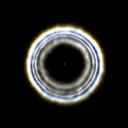Given typical dutch weather, it is nice to have a star of your own.
It is very helpful during collimation or playing with a Bahtinov mask.
I used a D-cell Maglite, single LED version.Place some aluminium foil over the LED and use a very sharp needle to puncture a tiny hole in the aluminium. Make sure you do not cover the LED in alumnium foil, the LED wil overheat and die.
When you place the artificial star at some distance (telescope still should be able to focus), the diameter of the hole should be smaller than the resolving power of your telescope.
Example for a Celestron C8:
- Resolving power: about 1.5 arc seconds
- Distance to the artificial star: 12 m.
- 1.5 arc seconds at 12m = tan(1.5/(60×60) degrees) x 12 m= 90 microns (about the diameter of a thick human hair)
An indication that the hole must be really small. That can be achieved by using a very sharp needle and by placing the aluminium foil on a hard and flat (glass) surface when puncturing it.



















